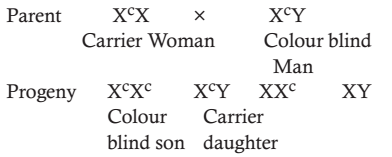Principles of Inheritance and Variation
- Genes for cytoplasmic male sterility in plants are generally located in
-
View Hint View Answer Discuss in Forum
Male sterility in plants can be controlled by nuclear genes or cytoplasm or by both. Three different mechanisms for control of male sterility in plants are:
(i) Genetic male sterility;
(ii) Cytoplasmic male sterility;
(iii) Cytoplasmic genetic male sterility.
In Maize the genes for cytoplasmic control of male sterility are located in cytoplasm.Correct Option: A
Male sterility in plants can be controlled by nuclear genes or cytoplasm or by both. Three different mechanisms for control of male sterility in plants are:
(i) Genetic male sterility;
(ii) Cytoplasmic male sterility;
(iii) Cytoplasmic genetic male sterility.
In Maize the genes for cytoplasmic control of male sterility are located in cytoplasm.
- A woman with normal vision, but whose father was colour blind, marries a colour blind man. Suppose that the fourth child of this couple was a boy. This boy
-
View Hint View Answer Discuss in Forum
Since the woman’s father was colour blind. She would be a carrier of the colour blindness gene. When she marries a colour blind man. Their progeny could be

Correct Option: A
Since the woman’s father was colour blind. She would be a carrier of the colour blindness gene. When she marries a colour blind man. Their progeny could be

- The salivary gland chromosomes in the dipteran larvae, are useful in gene mapping because:
-
View Hint View Answer Discuss in Forum
Polytene chromosomes were first reported by EG Balbiani in 1881. They are quite common in salivary glands of insects and are therefore popularly called salivary gland chromosomes. Polytene chromosomes also occur in other organs of insects antipodal cells (of embryo sac), endosperm cells and suspensor cell of embryo. The chromosomes can reach length of 200 µm and contain 1000 to 16000 times DNA as compared to the ordinary somatic chromosomes. The giant chromosomes are formed by somatic pairing between homologous chromosomes, and repeated replication (endomitosis) of their chromatids.
Correct Option: D
Polytene chromosomes were first reported by EG Balbiani in 1881. They are quite common in salivary glands of insects and are therefore popularly called salivary gland chromosomes. Polytene chromosomes also occur in other organs of insects antipodal cells (of embryo sac), endosperm cells and suspensor cell of embryo. The chromosomes can reach length of 200 µm and contain 1000 to 16000 times DNA as compared to the ordinary somatic chromosomes. The giant chromosomes are formed by somatic pairing between homologous chromosomes, and repeated replication (endomitosis) of their chromatids.
- At a particular locus, frequency of ‘A’ allele is 0.6 and that of ‘a’ is 0.4. What would be the frequency of heterozygotes in a random mating population at equilibrium?
-
View Hint View Answer Discuss in Forum
The mathematical expression to calculate allele frequency can be given as p + q = 1. Where p represents the frequency of dominant allele and q represents the frequency of recessive allele. The bionomial expression of Hardy Weinberg’s law to calculate genotype frequency is
p2 + 2pq + q2 = 1
where p2 = homozygous dominant
2pq = heterozygous dominant
q2 = homozygous recessive.
Frequency of heterozygous individuals = 2 × 0.6 × 0.4 = 0.48.Correct Option: D
The mathematical expression to calculate allele frequency can be given as p + q = 1. Where p represents the frequency of dominant allele and q represents the frequency of recessive allele. The bionomial expression of Hardy Weinberg’s law to calculate genotype frequency is
p2 + 2pq + q2 = 1
where p2 = homozygous dominant
2pq = heterozygous dominant
q2 = homozygous recessive.
Frequency of heterozygous individuals = 2 × 0.6 × 0.4 = 0.48.
- In order to find out the different types of gametes produced by a pea plant having the genotype AaBb, it should be crossed to a plant with the genotype:
-
View Hint View Answer Discuss in Forum
In order to find out the gamete or the genotype of an unknown individual, Scientists perform a test cross. In test cross the individual in question is crossed with the homozygous recessive parent. Hence the answer is aabb.
Correct Option: C
In order to find out the gamete or the genotype of an unknown individual, Scientists perform a test cross. In test cross the individual in question is crossed with the homozygous recessive parent. Hence the answer is aabb.

